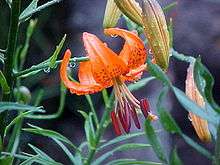Lilium davidii
| Lilium davidii | |
|---|---|
 | |
| Scientific classification | |
| Kingdom: | Plantae |
| (unranked): | Angiosperms |
| (unranked): | Monocots |
| Order: | Liliales |
| Family: | Liliaceae |
| Genus: | Lilium |
| Species: | L. davidii |
| Binomial name | |
| Lilium davidii Duch. ex Elwes | |
| Synonyms[1] | |
| |

L. davidii var. wilmottiae
Lilium davidii is an Asian species of plants in the lily family, native to mountainous areas of Assam, Manipur, Arunachal Pradesh, Tibet, Bhutan, Hubei, Shaanxi, Sichuan, Guizhou, and Yunnan.[1][2][3]
Lilium davidii grows up to 1.5m high, and bears up to about 20 unscented flowers with recurved leaves (bent backwards), orange or reddish orange, from July to August.[4]
The plant is cultivated for its edible bulb.[4] It is a stem-rooting lily (adventitious roots emerging above the bulb) that also forms bulbils.
The species is named for French missionary and naturalist Armand David (1826-1900).
References
- 1 2 Kew World Checklist of Selected Plant Families
- ↑ Karthikeyan, S., Jain, S.K., Nayar, M.P. & Sanjappa, M. (1989). Florae Indicae Enumeratio: Monocotyledonae: 1-435. Botanical Survey of India, Calcutta.
- ↑ Mao, A.A. & Bhaumik, M. (2007). Notes on Lilium davidii Duchartre - a rare beautiful lily from Manipur, India. Journal of Economic and Taxonomic Botany 31: 436-438.
- 1 2 Liang Songyun (梁松筠 Liang Song-jun); Minoru N. Tamura. "Flora of China".
|chapter=ignored (help)
- Patrick M. Synge: Collins Guide to Bulbs. 1961.
- European Garden Flora; vol. 1, 1986.
- Natural food-Vegetables
| Wikimedia Commons has media related to Lilium davidii. |
This article is issued from Wikipedia - version of the 4/29/2015. The text is available under the Creative Commons Attribution/Share Alike but additional terms may apply for the media files.